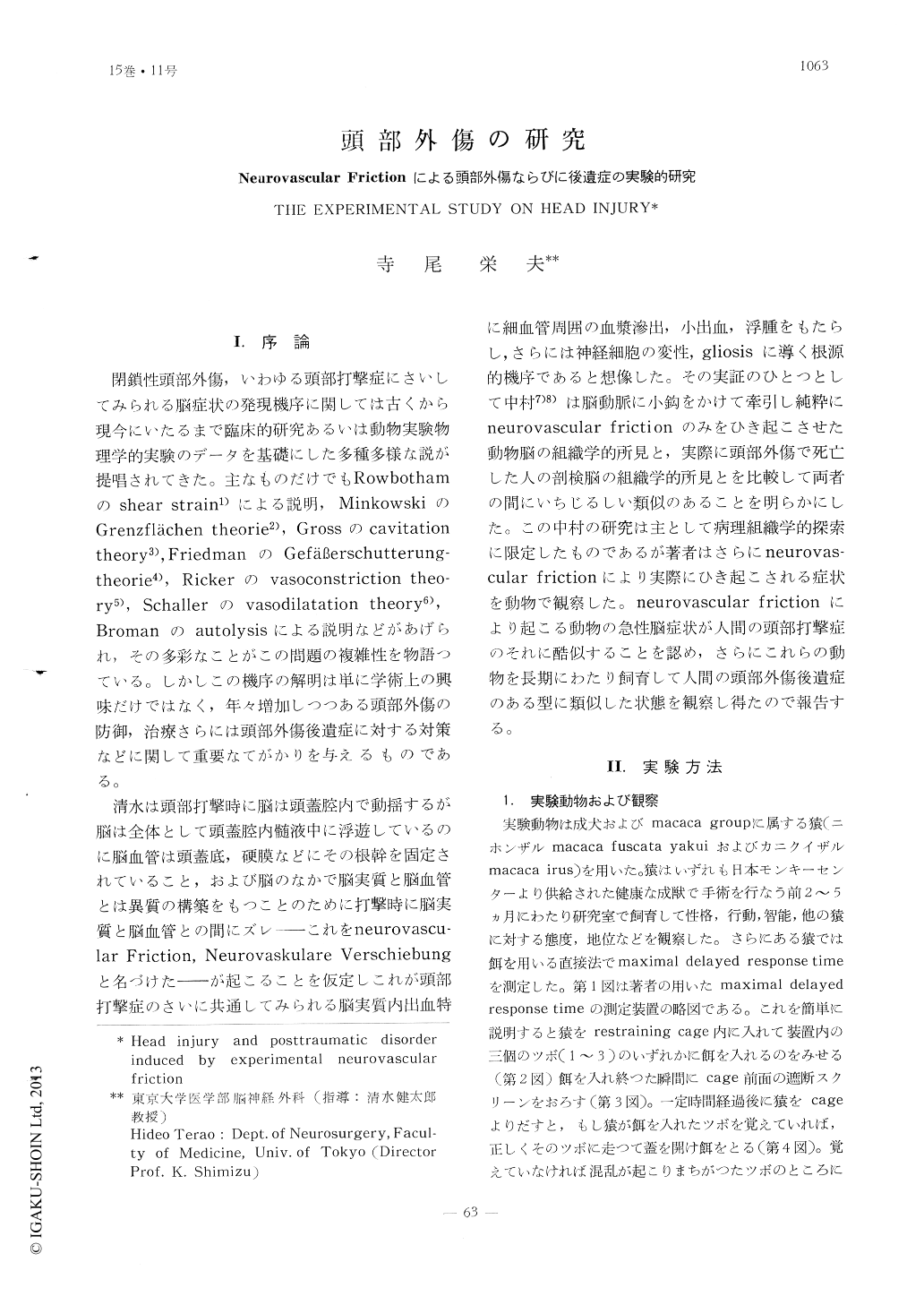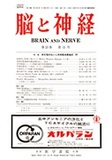Japanese
English
- 有料閲覧
- Abstract 文献概要
- 1ページ目 Look Inside
I.序論
閉鎖性頭部外傷,いわゆる頭部打撃症にさいしてみられる脳症状の発現機序に関しては古くから現今にいたるまで臨床的研究あるいは動物実験物理学的実験のデータを基礎にした多種多様な説が提唱されてきた。主なものだけでもRowbothamのshear strain1)による説明,MinkowskiのGrenzflächen theorie2),Grossのcavitation theory3),FriedmanのGefäβerschutterungtheorie4),Rickerのvasoconstriction theory5),Schallerのvasodilatation theory6),Bromanのautolysisによる説明などがあげられ,その多彩なことがこの問題の複雑性を物語つている。しかしこの機序の解明は単に学術上の興味だけではなく,年々増加しつつある頭部外傷の防御,治療さらには頭部外傷後遺症に対する対策などに関して重要なてがかりを与えるものである。
清水は頭部打撃時に脳は頭蓋腔内で動揺するが脳は全体として頭蓋腔内髄液中に浮遊しているのに脳血管は頭蓋底,硬膜などにその根幹を固定されていること,および脳のなかで脳実質と脳血管とは異質の構築をもつことのために打撃時に脳実質と脳血管との間にズレ――これをneurovascular Friction,Neurovaskulare Verschiebungと名づけた――が起こることを仮定しこれが頭部打撃症のさいに共通してみられる脳実質内出血特に細血管周囲の血漿滲出,小出血,浮腫をもたらし,さらには神経細胞の変性,gliosisに導く根源的機序であると想像した。その実証のひとつとして中村7)8)は脳動脈に小鈎をかけて牽引し純粋にneurovascular frictionのみをひき起こさせた動物脳の組織学的所見と,実際に頭部外傷で死亡した人の剖検脳の組織学的所見とを比較して両者の間にいちじるしい類似のあることを明らかにした。この中村の研究は主として病理組織学的探索に限定したものであるが著者はさらにneurovascular frictionにより実際にひき起こされる症状を動物で観察した。neurovascular frictionにより起こる動物の急性脳症状が人間の頭部打撃症のそれに酷似することを認め,さらにこれらの動物を長期にわたり飼育して人間の頭部外傷後遺症のある型に類似した状態を観察し得たので報告する。
We investigated clinical manifestations induced by a mechanism of neurovascular friction in dogs and monkeys. Craniotomy was performed in these animals, and fine stainless steel wire hooks were suspended on the cerebral arteries at different points in different animals. The free ends of these wire hooks were hitched on to the scalp through the wound. After varying intervals of between two to fourteen days after operation, after having assured that animals recovered completely from the effects of operation, the exposed ends of the wire were tugged briskly, two or three times. No matter which artery was subjected to traction, the animals lapsed into unconsciousness and collapsed immediately. The degree of disturbance of consciousness varied from slight clouding of consciousness to deep coma, and the duration of disturbance of consciousness also varied from a mere 5-6 minutes to 8 hours. During the period of unconsciousness a varied mixture of signs ranging from nausea and vomiting, acceleration of respiration, tachycadia, photophobia, urination, and exaggeration of reflex to hyperkinesis were observed. As time elapsed, consciousness was regained gradually and in the majority of cases the animals revealed no visible neurological defects. These manifestations greaatly resembled those found in the condition "commotio cerebri" in man. In some cases, temporary neurological symptoms, ascribable to the areas supplied by the artery tracted, were recognized. For example, traction of a middle cerebral artery caused temporary hemiparesis, monoparesis, or hypesthesia, and traction of a basilar artery was followed by temporary ataxia and/or nystagmus.
We observed these animals for long periods after traction, and noted various types of neurotic condition, which very resembled some types of posttraumatic neurosis in man.
Headache complaining behavoir, impairment of memory, character changes and disturbance of the autonomic nervous system were obsereed in some monkeys.
we were able to demonstrate the sequels of head injury ranging from cerebral concussion to posttraumatic neurosis in animals by traction on the cerebral arteries. Thus we conclude that the mechanism of neurovascular friction plays a great part in the development of symptoms in closed head injury.

Copyright © 1963, Igaku-Shoin Ltd. All rights reserved.


